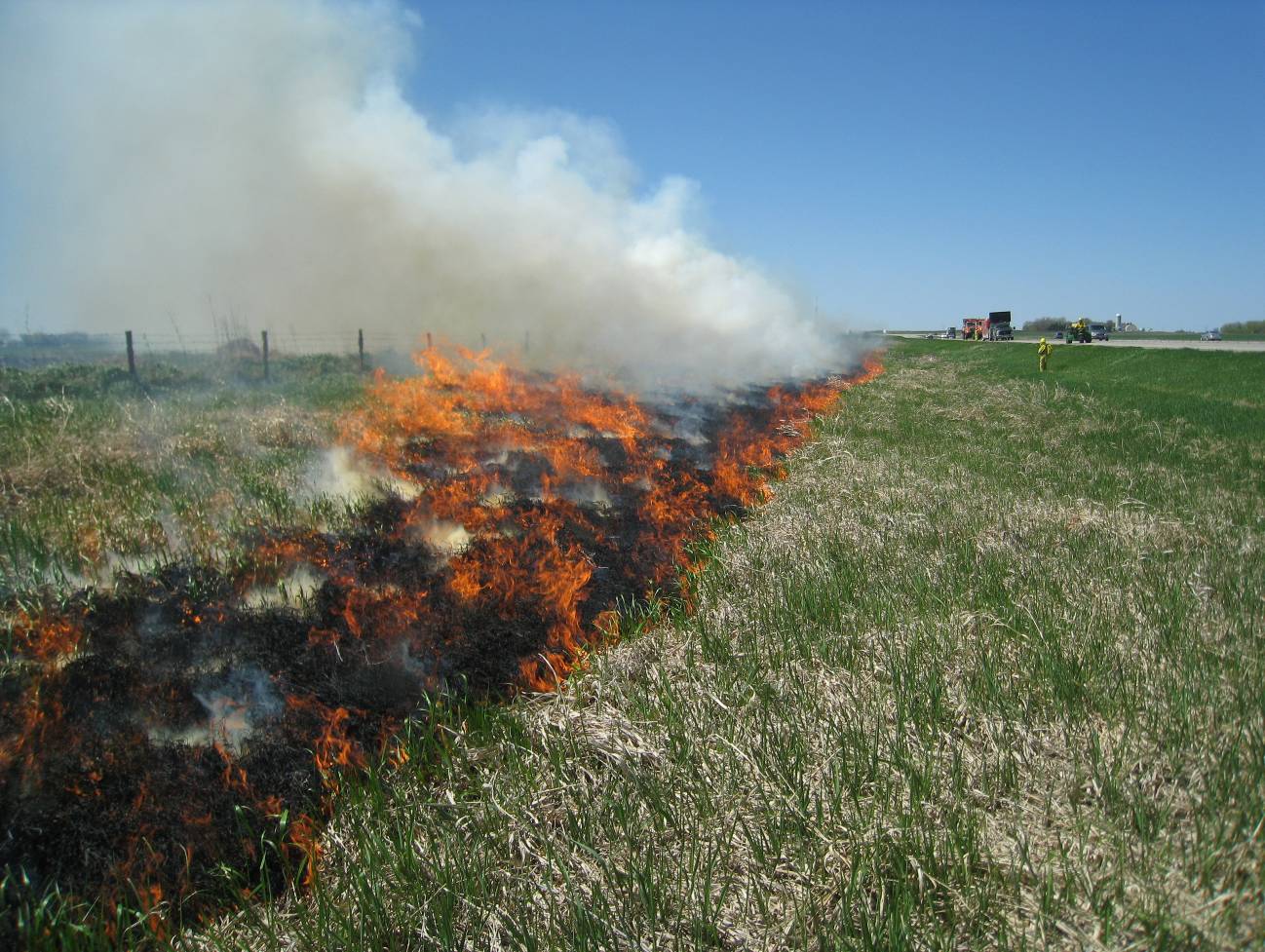Prescribed fire

Healthy roadside vegetation is necessary for preventing weed infestations, controlling erosion, protecting water quality and keeping roadways safe. Fire is an important aspect of vegetation management because many types of plants actually need fire for ideal growth. It's used in combination with mowing, herbicide application, biological control and planting in MnDOT’s Integrated Roadside Vegetation Management program.
How it works
Detailed planning ensures that a fire can accomplish its goal while still being kept under control. Prescribed fires are intended to accomplish specific vegetation management goals:
- Weather conditions are chosen carefully
- Necessary equipment and crews are coordinated
- Fire breaks are mowed where needed to improve control
- Authorities and nearby landowners are notified and DNR burn permits are obtained
MnDOT fire crew members have all been through a nationally recognized training for basic wildland firefighters. They are experienced in working with prescribed fires on roadsides and have all the necessary equipment to safely control the fire. See MnDOT's prescribed fire policy.
Benefits
- Better weed control: Simply spraying weeds does little to prevent repeat infestations. After weeds are controlled, there needs to be desirable vegetation that can fill in to prevent future weed problems. Fire promotes dense stands of native plants that can out-compete weeds and make it harder for them to get established.
- Better water quality: Fire encourages dense native vegetation with deep root systems that prevent erosion and filter storm water runoff.
- Better safety: Prescribed fire is used to control brush and small trees near the roadway, which would otherwise become safety hazards. Fire promotes tall native grasses and forbs that trap blowing snow and prevent it from drifting across the road.
Where we use fire
In spring and fall, MnDOT prescribed fire crews may be seen burning in the following areas:
District 2 Northwest Minnesota
- Fischer's Landing Rest Area (On US hwy 2)
- TH 2 Polk Co.
- TH 9 Polk Co.
- TH 11 Roseau Co.
- TH 32 Marshall, Pennington, and Red Lake Co.
- TH 59 Kittson, Marshall, Polk, and Red Lake Co.
- TH 75 Kittson, Marshall, Norman, Polk Co.
- TH 102 Polk Co.
District 3 Central Minnesota
- Lake Wobegon Trail
- St Cloud Travel Information Center on Hwy 10
- MnROAD Research Center (I-94 Albertville)
- Spunk Lake Rest Area (I-94 Avon)
- TH 10 Wadena Co.
- TH 23 Stearns Co.
- TH 55 Kandiyohi, Stearns Co.
- TH 65 Isanti Co.
- TH 71 Todd, Wadena Co.
- TH 371 Crow Wing, Morrison
District 4 West Central Minnesota
- TH 9 Clay, Grant, Stevens, Traverse Co.
- TH 10 Ottertail Co.
- TH 12 Big Stone, Swift Co.
- TH 29 Ottertail Co.
- TH 32 Clay Co.
- TH 59 Chippewa, Ottertail, Stevens, Swift Co.
- TH 75 Clay, Wilkins Co.
- TH 78 Ottertail Co.
- TH 87 Ottertail Co.
- TH 94 Ottertail Co.
- TH 108 Ottertail Co.
District 6 Southeast Minnesota
- I-35 Freeborn, Rice, Steele Co.
- I-90 Olmstead
- TH 13 Freeborn Co
- TH 14 Olmstead, Steele Co
- TH 42 Wabasha Co
- TH 52 Fillmore Co
- TH 56 Fillmore, Goodhue, Mower Co
- Th 65 Freeborn Co
- TH 109 Freeborn
- TH 218 Dodge, Mower, Steele Co
District 7 Southwest Minnesota
- I-90 Blue Earth, Faribault, Jackson Co
- TH 4 Martin, Watonwan Co
- TH 5 Sibley Co
- TH 14 Brown, Waseca Co
- TH 19 Renville, Sibley Co
- TH 22 Blue Earth, Faribault Co
- TH 60 Cottonwood, Jackson, Nobles Co
District 8 Southwest Minnesota
- TH 12 Kandiyohi, Meeker Co
- TH 19 Renville Co
- TH 23 Chippewa, Kandiyohi, Lyon, Pipestone Co
- TH 40 Lac Qui Parle Co
- TH 59 Chippewa Co
- TH 212 McCloud, Renville Co
Twin Cities Metro Area
- Wetland mitigation near Jordan
- Wetland mitigation near Rockford
- Wetland mitigation near Minnetrista
- Wetland mitigation near Waconia
How you can help
If you're driving by a prescribed fire in progress, treat the area as a work zone. There will be workers on the roadside, so concentrate on driving and follow any temporary traffic instructions. There is no need to report fires that are attended by a burn crew or when “Controlled Burn Ahead” signs are placed beside the road.
Contact
Nate Johnson
612-723-4288
